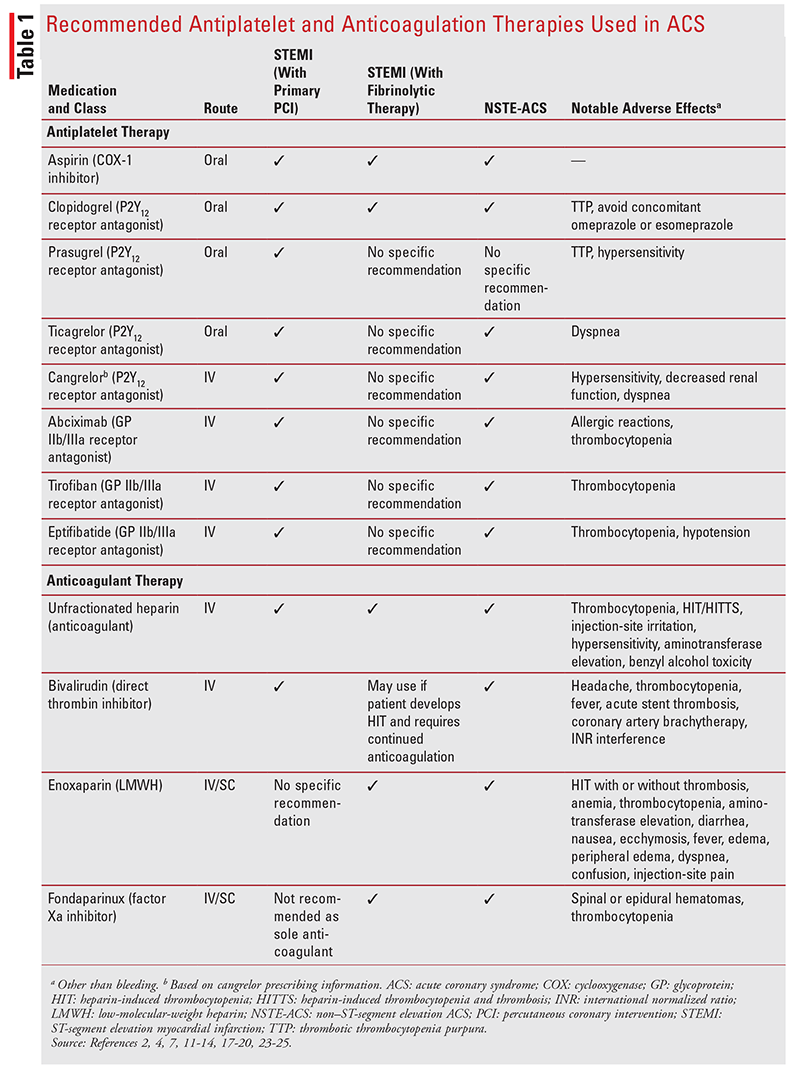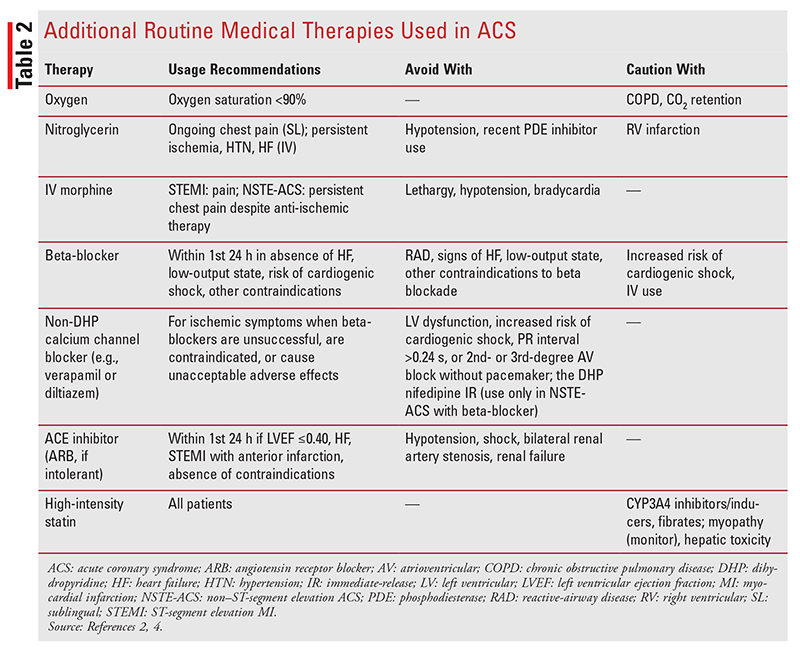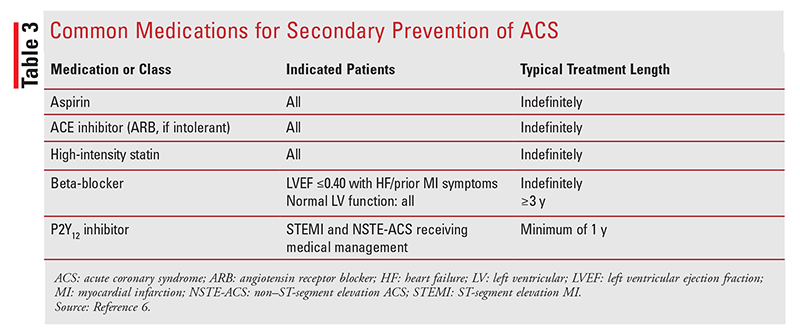US Pharm. 2020;45(2):HS7-HS12.
ABSTRACT: Acute coronary syndrome (ACS) is a common cause of morbidity and mortality in the United States. In 2014, more than 1.3 million hospital discharges, including 71% of patients with myocardial infarction, had a primary or secondary diagnosis of ACS. The proper management of ACS and the appropriate use of pharmacotherapy are critical in preventing the recurrence of cardiac events. Given the importance of medication adherence, pharmacists play an important role in the management of ACS and secondary prevention.
Cardiovascular disease is the leading cause of mortality in the United States, and coronary heart disease is the most common reason for cardiovascular death.1 The term acute coronary syndrome (ACS) comprises the three types of coronary heart disease characterized by acute myocardial ischemia and/or myocardial infarction (MI).2 This article will review ACS, current treatments, and secondary-prevention recommendations and will highlight key areas for pharmacist intervention.
EPIDEMIOLOGY
ACS is a common cause of morbidity and mortality. Every 40 seconds, someone in the U.S. experiences an MI.1 In 2014, more than 1.3 million hospital discharges, including 71% of patients with MI, had a primary or secondary diagnosis of ACS.1 Males experience ACS more often than females do, with a ratio of approximately 1.4:1.1
DISEASE-STATE OVERVIEW
ACS results from the sudden imbalance of myocardial oxygen demand and supply, most typically secondary to obstruction of blood flow in the coronary artery.2 Obstruction may occur through rupture or erosion of a vulnerable, lipid-laden, atherosclerotic plaque with a fibrous cap that partially or completely occludes a coronary artery.2,3 Disruption of the fibrous cap stimulates thrombogenesis.2,3 Thrombus formation and vasospasm of the coronary artery reduce blood flow and cause ischemic chest pain, the classic symptom of ACS.2,3 The pressure-like chest pain often radiates to the left arm, the neck, or the jaw.3 Accompanying symptoms may include dyspnea, sweating, cool or clammy skin, nausea, vomiting, and unexplained fatigue.3 The median age of ACS diagnosis in the U.S. is 68 years.2
DIAGNOSIS
ACS is subdivided into three diagnoses: ST-segment elevation MI (STEMI), typically associated with complete coronary artery occlusion; non–ST-segment elevation MI (NSTEMI); and unstable angina (UA).2-4 Differentiation of ACS subtypes is based on ECG changes and the presence of cardiac biomarkers.2 STEMI is characterized by persistent ST elevation on ECG, with the release of biomarkers, such as cardiac troponins, indicating myocardial necrosis.4 About 75% of patients with ACS have non–ST-segment elevation ACS (NSTE-ACS), which includes NSTEMI and UA.2 NSTE-ACS does not have persistent ST elevation on ECG.2 Patients diagnosed with NSTEMI have elevated cardiac biomarkers, whereas those with UA do not.2 Patients with NSTE-ACS typically have more comorbid conditions than do patients with STEMI.2
TREATMENT
General Treatment
Treatment for ACS is time sensitive, multifaceted, and dependent on a specific diagnosis. The American College of Cardiology (ACC) and the American Heart Association (AHA) have developed several practice guidelines for treatment and secondary prevention of ACS.2,4-6 These guidelines, which form the basis of this review, should be consulted for more detailed information.
Reperfusion Therapy
Quick reestablishment of coronary perfusion is the cornerstone of STEMI treatment.3,4 Reperfusion, which may be achieved via mechanical (e.g., primary percutaneous coronary intervention [PCI]) or pharmacologic (e.g., fibrinolytic) means, should be administered to all eligible STEMI patients who have experienced ischemic symptoms for more than 12 hours.4 Primary PCI of the affected area within 90 minutes of hospital arrival is preferred over fibrinolytic therapy when time to treatment delay is short and the hospital is capable of performing PCI.4 PCI is often accompanied by the placement of bare-metal or drug-eluting stents.4 If PCI is not possible, fibrinolytic therapy is recommended within 30 minutes of hospital arrival.4,7 Transfer to a PCI-capable hospital within 24 hours of fibrinolysis may also improve outcomes.4,7
NSTE-ACS patients with an elevated mortality risk may also be eligible for early revascularization with PCI or coronary artery bypass graft, whereas those not at high risk may be managed with an ischemia-guided strategy involving delayed PCI or medical management alone.2 Approximately 32% to 40% of patients with NSTE-ACS undergo PCI.2 Fibrinolytic therapy is not recommended for NSTE-ACS owing to a lack of data demonstrating benefits for mortality or MI and increased intracranial hemorrhage.2,7
The benefits of early fibrinolytic therapy are well established in STEMI patients who cannot undergo PCI.4 Three IV fibrinolytic agents are available in the U.S.: the tissue plasminogen activators tenecteplase, reteplase, and alteplase.8-10 All exert a thrombolytic effect by binding to fibrin and converting plasminogen to plasmin, which then breaks cross-links between fibrin molecules of the thrombus.8-10 Fibrinolytics increase the risk of bleeding and are contraindicated in situations in which excess bleeding may occur, such as recent stroke and active internal bleeding.8-10
Medical Management
Regardless of reperfusion strategy, dual antiplatelet therapy and anticoagulation are recommended for treating ACS.2,4,5 A number of antiplatelet and anticoagulant medications are available (TABLE 1). Pharmacists can play a key role in medication management and patient counseling, particularly concerning bleeding risk.

Antiplatelet Therapy: Aspirin is the standard of care for all patients presenting with ACS.2,4 Its antiplatelet effect is mediated through irreversible inactivation of platelet cyclooxygenase-1, which prevents synthesis of thromboxane A2, a potent agonist of platelet aggregation.2 Aspirin prevents acute thrombotic occlusion during PCI, reduces the risk of stent thrombosis, and has proven beneficial effects with fibrinolytic therapy.4 In patients with NSTE-ACS, aspirin has been found to reduce the incidence of recurrent MI and death.2 Aspirin should be administered orally as soon as possible upon initial presentation and continued indefinitely.2,4,7
A P2Y12 inhibitor should be administered with aspirin in ACS patients in order to provide dual antiplatelet therapy.2,4 P2Y12 inhibitors interfere with platelet activation and aggregation by preventing adenosine diphosphate from binding to the P2Y12 platelet receptor site.11-14 Four P2Y12 inhibitors are available in the U.S.; clopidogrel, prasugrel, and ticagrelor are administered orally and are included in the ACC/AHA STEMI and NSTE-ACS guidelines, whereas cangrelor is administered IV and was approved after the last guideline updates.11-14 Loading doses of P2Y12 inhibitors should be administered before or at the time of primary PCI or fibrinolytic therapy.4 Maintenance doses of the oral agents should be continued for up to 1 year.2,4
The benefits of dual antiplatelet therapy were first demonstrated in the landmark 2001 trial, Clopidogrel in Unstable Angina to Prevent Recurrent Events (CURE).15 In this trial, more than 12,000 NSTE-ACS patients received treatment with aspirin plus clopidogrel or aspirin alone.15 At 12 months, the aspirin-plus-clopidogrel group had a reduced risk of cardiovascular death, MI, or stroke compared with the aspirin-alone group (9.3% vs. 11.4%; relative risk, 0.80; 95% CI, 0.72-0.90; P <.001), with no significant differences in episodes of hemorrhagic stroke or life-threatening bleeding.15 In 2005, two studies showed positive results for aspirin plus clopidogrel in patients with STEMI.16 Since that time, clopidogrel, prasugrel, ticagrelor, and cangrelor have been investigated and compared in a variety of ACS studies, each showing benefits and risks of a specific combination.2,4,16
Abciximab, eptifibatide, and tirofiban are IV glycoprotein (GP) IIb/IIIa receptor antagonists that target the final common pathway of platelet aggregation.2 GP IIb/IIIa receptor antagonists may be used adjunctively at the time of PCI in selected patients with STEMI and NSTE-ACS who are receiving unfractionated heparin.2,4 Because of the increased availability of oral antiplatelets, however, these agents are used much less often in patients with ACS.3 Concomitant use of aspirin and P2Y12 inhibitors has been associated with an increased risk of bleeding, and GP IIb/IIIa inhibitors are not routinely recommended in patients receiving the anticoagulant bivalirudin.4,7 Intracoronary administration of abciximab may be appropriate in some patients.4 In patients with NSTE-ACS, tirofiban and eptifibatide are preferred.2
ACC/AHA guidelines do not recommend one antiplatelet over another; they advise that antiplatelet use closely mirror the use in studies and that it be individualized in terms of benefit and risk.2,4 Bleeding, sometimes life-threatening or fatal, is generally the most common adverse reaction for antiplatelet agents.2,11-14,17-19
Anticoagulation Therapy: Anticoagulation therapy plays an important role in managing ACS.7 STEMI patients undergoing PCI should receive unfractionated heparin titrated to a therapeutic activated clotting time.4,7 Bivalirudin may also be used with or without prior treatment with unfractionated heparin and is preferred over unfractionated heparin plus a GP IIb/IIIa antagonist in patients with a high bleeding risk.4,7,20 Data on the use of enoxaparin and fondaparinux in these patients are limited.4 Additionally, fondaparinux should not be used as the sole anticoagulant with PCI because it has been associated with catheter thrombosis.4 STEMI patients undergoing fibrinolytic therapy may be given unfractionated heparin, enoxaparin, or fondaparinux for a minimum of 48 hours and up to 8 days or until revascularization.4
For patients with NSTE-ACS, enoxaparin, bivalirudin, fondaparinux, and unfractionated heparin are options; enoxaparin is the most strongly recommended.2 Enoxaparin or fondaparinux is administered SC for the duration of hospitalization or until PCI is performed.2 If PCI is performed with fondaparinux, unfractionated heparin or bivalirudin should be administered to reduce the risk of catheter thrombosis.2 Bivalirudin may be used in patients managed with an early invasive strategy until diagnostic angiography or PCI.2 Unfractionated heparin may be administered for 48 hours or until PCI.2
Additional Routine Medical Therapies: Other routine therapies for patients with ACS are supplemental oxygen, nitroglycerin, IV morphine, beta-blockers, calcium channel blockers, ACE inhibitors, and high-intensity statins (TABLE 2).2,4,7 These therapies may be used in patients experiencing STEMI or NSTE-ACS and are given in combination with antiplatelet and anticoagulation therapy.

SECONDARY PREVENTION
After a patient experiences an ACS event, long-term treatment and follow-up are essential to prevent a future event or death.6 Medications for secondary prevention, including aspirin, ACE inhibitors, statins, beta-blockers, and P2Y12 inhibitors (TABLE 3), should be initiated prior to hospital discharge.6 Additional secondary-prevention therapies for consideration include blood pressure control, diabetes management, smoking cessation, weight management, suitable physical activity, influenza vaccination, and cardiac rehabilitation.6

THE PHARMACIST’S ROLE
Medication adherence is paramount in the treatment and secondary prevention of ACS because poor adherence can lead to worsened cardiovascular outcomes, including increased mortality.21,22 A Canadian cohort study found that just 73% of ACS patients filled their discharge prescriptions 1 week after hospital discharge, and mortality rates at 1 year were higher in patients who filled none versus some or all of their prescriptions.21 Secondary adherence (i.e., continuation of medication) was found to be low in several studies of ACS patients, with fewer than 45% of patients adhering to beta-blocker or statin therapy 1 to 2 years after an ACS event.22 Potential reasons for low adherence vary by patient but may include lack of motivation, forgetfulness, lack of medication education, depression, regimen complexity, and adverse effects; additionally, older patients and those with comorbidities are often less adherent.22 Pharmacists can play a key role in patient education by explaining the need for each medication and signs of adverse effects, directly encouraging the patient to refill the prescription and having the outpatient pharmacy provide refill reminders, and monitoring adherence.
In addition to assisting with adherence, pharmacists can help ensure that their patients are prescribed all essential medications at each stage of illness. They can evaluate drug-drug interactions and recommend alternative agents when appropriate (e.g., patients taking clopidogrel should not receive omeprazole or esomeprazole, which significantly reduce antiplatelet activity).11 Pharmacists can educate patients about medications, common adverse effects, and appropriate lifestyle modifications.6
REFERENCES
1. Benjamin EJ, Muntner P, Alonso A, et al. Heart disease and stroke statistics—2019 update: a report from the American Heart Association. Circulation. 2019;139:e56-e528.
2. Amsterdam EA, Wenger NK, Brindis RG, et al. 2014 AHA/ACC Guideline for the Management of Patients With Non–ST-Elevation Acute Coronary Syndromes: a report of the American College of Cardiology/American Heart Association Task Force on Practice Guidelines. J Am Coll Cardiol. 2014;64:e139-e228.
3. Makki N, Brennan TM, Girotra S. Acute coronary syndrome. J Intensive Care Med. 2015;30:186-200.
4. O’Gara PT, Kushner FG, Ascheim DD, et al. 2013 ACCF/AHA guideline for the management of ST-elevation myocardial infarction: a report of the American College of Cardiology Foundation/American Heart Association Task Force on Practice Guidelines. J Am Coll Cardiol. 2013;61:e78-e140.
5. Levine GN, Bates ER, Bittl JA, et al. 2016 ACC/AHA Guideline Focused Update on Duration of Dual Antiplatelet Therapy in Patients With Coronary Artery Disease: a report of the American College of Cardiology/American Heart Association Task Force on Clinical Practice Guidelines. J Am Coll Cardiol. 2016;68:1082-1115.
6. Smith SC Jr, Benjamin EJ, Bonow RO, et al. AHA/ACCF secondary prevention and risk reduction therapy for patients with coronary and other atherosclerotic vascular disease: 2011 update: a guideline from the American Heart Association and American College of Cardiology Foundation. Circulation. 2011;124:2458-2473.
7. Switaj TL, Christensen SR, Brewer DM. Acute coronary syndrome: current treatment. Am Fam Physician. 2017;95:232-240.
8. TNKase (tenecteplase) package insert. South San Francisco, CA: Genentech, Inc; August 2018.
9. Retavase (reteplase) package insert. Cary, NC: Chiesi USA, Inc; June 2017.
10. Activase (alteplase) package insert. South San Francisco, CA: Genentech, Inc; February 2018.
11. Plavix (clopidogrel) package insert. Bridgewater, NJ: Bristol-Myers Squibb/Sanofi Pharmaceuticals Partnership; May 2019.
12. Effient (prasugrel) package insert. Indianapolis, IN: Eli Lilly and Co; March 2019.
13. Brilinta (ticagrelor) package insert. Wilmington, DE: AstraZeneca Pharmaceuticals LP; October 2019.
14. Kengreal (cangrelor) package insert. Cary, NC: Chiesi USA, Inc; October 2019.
15. Yusuf S, Zhao F, Mehta SR, et al. Effects of clopidogrel in addition to aspirin in patients with acute coronary syndromes without ST-segment elevation. N Engl J Med. 2001;345:494-502.
16. Szummer K, Jernberg T, Wallentin L. From early pharmacology to recent pharmacology interventions in acute coronary syndromes: JACC state-of-the-art review. J Am Coll Cardiol. 2019;74:1618-1636.
17. ReoPro (abciximab) package insert. Horsham, PA: Janssen Biotech, Inc; June 2018.
18. Aggrastat (tirofiban) package insert. Princeton, NJ: Medicure Pharma, Inc; May 2019.
19. Integrilin (eptifibatide) package insert. Whitehouse Station, NJ: Merck & Co, Inc; October 2019.
20. Angiomax (bivalirudin) package insert. Parsippany, NJ: The Medicines Co; March 2016.
21. Jackevicius CA, Li P, Tu JV. Prevalence, predictors, and outcomes of primary nonadherence after acute myocardial infarction. Circulation. 2008;117:1028-1036.
22. Cheng K, Ingram N, Keenan J, Choudhury RP. Evidence of poor adherence to secondary prevention after acute coronary syndromes: possible remedies through the application of new technologies. Open Heart. 2015;2:e000166.
23. Heparin sodium injection package insert. New York, NY: Pfizer Inc; September 2019.
24. Lovenox (enoxaparin) package insert. Bridgewater, NJ: Sanofi-aventis US LLC; December 2018.
25. Arixtra (fondaparinux) package insert. Rockford, IL: Mylan Institutional LLC; August 2017.
To comment on this article, contact rdavidson@uspharmacist.com.





